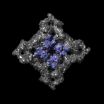(Press-News.org) It's commonly accepted that we appreciate something more if we have to work hard to get it, and a Johns Hopkins University study bears that out, at least when it comes to food.
The study seems to suggest that hard work can even enhance our appreciation for fare we might not favor, such as the low-fat, low calorie variety. At least in theory, this means that if we had to navigate an obstacle course to get to a plate of baby carrots, we might come to prefer those crunchy crudités over the sweet, gooey Snickers bars or Peanut M&Ms more easily accessible via the office vending machine.
"Basically, what we have shown is that if you have to expend more effort to get a certain food, not only will you value that food more, but it might even taste better to you," explained Alexander Johnson, an associate research scientist in the Department of Psychological and Brain Sciences at the Krieger School of Arts and Sciences at Johns Hopkins. "At present, we don't know why effort seems to boost the taste of food, but we know that it does, and this effect lasts for at least 24 hours after the act of working hard to get the food."
The study, titled "Greater effort boosts the affective taste properties of food," appears in this week's issue of the Proceedings of the Royal Society B.
The study results are significant not only because they hold out hope that people who struggle to maintain a healthy weight could be conditioned to consume lower calorie foods, but because they also might provide insight into methods of altering other less-than-optimal behavior, according to Johnson, who led the study.
Johnson teamed up on the project with Michela Gallagher, the Krieger-Eisenhower Professor of Psychological and Brain Sciences and Neuroscience and vice provost for academic affairs at Johns Hopkins. Using ordinary laboratory mice, the team conducted two experiments.
In the first, mice were trained to respond to two levers. If the mice pressed one lever once, they were rewarded with a sugary treat. Another lever had to be pressed 15 times to deliver a similar snack. Later, when given free access to both tidbits, the rodents clearly preferred "the food that they worked harder for," Johnson said.
In the second experiment, the team wanted to ascertain whether the animals' preference for the harder-to-obtain food would hold if those morsels were low-calorie. So half the mice received lower calorie goodies from a high-effort lever, and half got them from a low-effort lever. When both groups of mice were given free access to the low-calorie food later, those who had used the high-effort lever ate more of it and even seemed to enjoy it more than did the other group.
"We then analyzed the way in which the mice consumed the food," Johnson explained. "Why did we do this? Because food intake can be driven by a variety of factors, including how it tastes, how hungry the mice were beforehand, and how 'sated' or full the food made them feel."
Johnson and Gallagher used licking behavior as a measure of the rodents' enjoyment of their treats, and found that the mice that had to work harder for their low-cal rewards did, in fact, savor them more.
"Our basic conclusion is that under these conditions, having to work harder to get a certain food changes how much that food is valued, and it does that by changing how good that food tastes," Johnson said. "This suggests that, down the road, obese individuals might be able to alter their eating habits so as to prefer healthier, low calorie food by manipulating the amount of work required to obtain the food. Of course, our study didn't delve into that aspect. But the implications certainly are there."
INFORMATION:
The study was funded by grants from the National Institute of Diabetes and Digestive and Kidney Diseases and the National Institute of Mental Health.
Copies of the study are available from Lisa De Nike at Lde@jhu.edu or 443-287-9960.
Hard work improves the taste of food, Johns Hopkins study shows
2010-11-05
ELSE PRESS RELEASES FROM THIS DATE:
Burning pain and itching governed by same nerve cells
2010-11-05
There are disorders and conditions that entail increased itching and can be extremely troublesome for those suffering from it. The mechanisms behind itching are not well understood today. For one thing, what is it about scratching that relieves itching?
In the current study, which was performed on mice, the research team led by Professor Klas Kullander at the Department of Neuroscience examined the nerve cells that transfer heat pain. When these nerve cells had lost its capacity to signal, the mice reacted less to heat, as expected, but surprisingly they also started ...
UMD-led deep impact spacecraft successfully flies by comet Hartley 2
2010-11-05
COLLEGE PARK, Md. – The University of Maryland-led EPOXI mission successfully flew by comet Hartley 2 at 10 a.m. EDT today, and the spacecraft has begun returning images. Hartley 2 is the fifth comet nucleus visited by any spacecraft and the second one visited by the Deep Impact spacecraft.
Scientists and mission controllers are studying never-before-seen images of Hartley 2 appearing on their computer terminal screens. See images at: http://epoxi.umd.edu/
"We are all holding our breath to see what discoveries await us in the observations near closest approach," said ...
Researchers unlock the secret of bacteria's immune system
2010-11-05
Quebec City, November 4, 2010—A team of Université Laval and Danisco researchers has just unlocked the secret of bacteria's immune system. The details of the discovery, which may eventually make it possible to prevent certain bacteria from developing resistance to antibiotics, are presented in today's issue of the scientific journal Nature.
The team led by Professor Sylvain Moineau of Université Laval's Department of Biochemistry, Microbiology, and Bioinformatics showed that this mechanism, called CRISPR/Cas, works by selecting foreign DNA segments and inserting them ...
A 'brand' new world: Attachment runs thicker than money
2010-11-05
Can you forge an emotional bond with a brand so strong that, if forced to buy a competitor's product, you suffer separation anxiety? According to a new study from the USC Marshall School of Business, the answer is yes. In fact, that bond can be strong enough that consumers are willing to sacrifice time, money, energy and reputation to maintain their attachment to that brand.
"Brand Attachment and Brand Attitude Strength: Conceptual and Empirical Differentiation of Two Critical Brand Equity Drivers," a study published in the November issue of the Journal of Marketing, ...
X-rays offer first detailed look at hotspots for calcium-related disease
2010-11-05
Menlo Park, Calif.—Calcium regulates many critical processes within the body, including muscle contraction, the heartbeat, and the release of hormones. But too much calcium can be a bad thing. In excess, it can lead to a host of diseases, such as severe muscle weakness, a fatal reaction to anesthesia or sudden cardiac death.
Now, using intense X-rays from the Stanford Synchrotron Radiation Lightsource (SSRL) at the Department of Energy's SLAC National Accelerator Laboratory, researchers have determined the detailed structure of a key part of the ryanodine receptor, a ...
Colonic navigation
2010-11-05
Nanoparticles could help smuggle drugs into the gut, according to a study published this month in the International Journal of Nanotechnology.
There are several drugs that would have more beneficial therapeutic effects if they could be targeted at absorption by the lower intestine. However, in order to target the colon for treating colon cancer for instance, medication delivered by mouth must surmount several barriers including stomach acidity, binding to mucus layers, rapid clearance from the gut, and premature uptake by cells higher up the gastrointestinal tract. Being ...
Helical CT scans reduce lung cancer mortality by 20 percent compared to chest X-rays
2010-11-05
PROVIDENCE, R.I. [Brown University] — In a major new study announced today by the National Cancer Institute, researchers including Brown University biostatistian Constantine Gatsonis and his colleagues found that screening for lung cancer using helical CT scanning reduced lung cancer deaths by 20 percent compared to using chest X-rays.
"The findings we're announcing today offer the first definitive evidence for the effectiveness of helical CT screening smokers for lung cancer " said Gatsonis, a lead biostatistician in the study and director of the American College of ...
Motor Neurone Disease Association study identifies MND biomarker
2010-11-05
A study funded by the Motor Neurone Disease (MND) Association, in collaboration with the Medical Research Council (MRC), has identified a common signature of nerve damage in the brains of MND patients.
The study's exciting findings have been published in the prestigious journal Neurology (2 November 2010). These are the first results to be published from the ongoing Oxford Study for Biomarkers in MND/ALS (BioMOx).
MND research is being held back by the lack of an early diagnostic test and predictable markers of the progression of the disease – biomarkers. Patients ...
The mind uses syntax to interpret actions
2010-11-05
Most people are familiar with the concept that sentences have syntax. A verb, a subject, and an object come together in predictable patterns. But actions have syntax, too; when we watch someone else do something, we assemble their actions to mean something, according to a new study published in Psychological Science, a journal of the Association for Psychological Science.
"There are oceans and oceans of work on how we understand languages and how we interpret the things other people say," says Matthew Botvinick of Princeton University, who cowrote the paper with his ...
AGU Journal highlights -- Nov. 4, 2010
2010-11-05
The following highlights summarize research papers that have been recently published in Geophysical Research Letters (GRL), Journal of Geophysical Research - Atmospheres (JGR-D), and Journal of Geophysical Research - Earth Surface (JGR-F).
1. Exploring climate patterns linking stratosphere, lower atmosphere
Roughly every 28 months, the zonal winds in the stratosphere at the equator cycle from easterly to westerly and then back to easterly. Known to atmospheric scientists as the quasi-biennial oscillation (QBO), these shifting wind patterns result when the energy from ...

